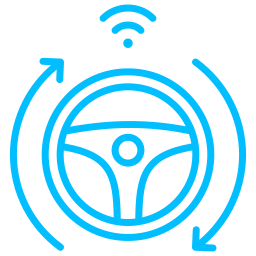Automotive Industry
Nestack Technologies advances automotive innovation with Machine Learning and customized, effective Software Development Services.

Machine Learning in Automotive
Machine Learning is transforming the automotive industry, driving innovation, efficiency and better customer experiences, shaping the future of connected vehicles.
Autonomous Driving
Machine Learning plays a critical role in enabling autonomous driving and ADAS technologies. ML algorithms can analyze sensor data, including radar, LiDAR and camera inputs, to perceive the vehicle's surroundings, detect objects and make real-time decisions. By continuously learning from data, ML models improve their ability to recognize and respond to complex driving scenarios, enhancing both safety and efficiency.
Demand Forecasting and Inventory Management
ML algorithms can analyze historical sales data, economic indicators, and customer behavior to forecast demand accurately. By understanding customer preferences and market trends, automotive companies can optimize production schedules, inventory levels and pricing strategies, resulting in improved supply chain efficiency and reduced costs.
Predictive Maintenance and Fault Detection
ML algorithms can analyze vehicle sensor data, historical maintenance records and machine learning models to predict and identify potential faults and maintenance requirements in real-time. By detecting early signs of component failure or degradation, automotive companies can perform preventive maintenance, reducing downtime and improving vehicle reliability.
Enhancing User Experience and Personalization
ML algorithms enable automotive companies to provide personalized user experiences through voice recognition, natural language processing and predictive analytics. By understanding user preferences, driving behavior and connectivity patterns, ML models can customize in-car infotainment, navigation systems and personalized recommendations, enhancing the overall driving experience.
Tech and tools we use to build Automotive Software
We use top tools, the latest technologies and modern methods to help grow your business.
Modern Technologies
Artificial Intelligence
Machine Learning
Augmented Reality
Computer Vision
Internet of Things
Virtual Reality
Front-End Technologies
ReactJS
AngularJS
Vue.js
Next.js
CSS
HTML
JavaScript
Back-end Technologies
Node.js
Python
Java
Microsoft .NET
PHP
ROR
Golang
DevOps
Docker
Kubernetes
MESOS
OPENSHIFT
AWS Developer Tools
Azure DevOps
Google Developer Tools
Many More..
Databases
SQLServer
MySQL
ORACLE
PostgreSQL
Cassandra
MongoDB
Mobile Application Development
Flutter
Cordova
Swift
Xamarin
IONIC
React Native
Desktop Technologies
C++
Microsoft WPF
Python
C#
QT
OBJ-C
Cloud
AWS
Azure
Google Cloud
Why You Should Hire from Nestack
We deliver result-driven Automotive Software Development Services tailored for your business.
Quick hiring
Focus on your core business activities while we handle the complexities of application development. Our quick and straightforward hiring process ensures you receive the right developers tailored to your project's requirements.
Scalable Teams
Build your next application with our dynamic team, capable of scaling up to maintain exceptional quality. We are committed to delivering high-performance applications that meet your needs.
Robust Coding Practices
Our developers craft robust code designed to manage unexpected challenges and errors effectively. We ensure your application remains stable, reliable and adaptable to evolving business requirements.
Cost-Effective Solutions
Receive superior quality applications at competitive prices. We are dedicated to delivering your projects on time and within budget, ensuring optimal financial efficiency.
How We Build Automotive Software
We continuously refine our software development life cycle to establish more efficient workflows, enabling us to deliver superior software more rapidly for the Automotive industry.
Get Your Artificial Intelligence Consultation
Don’t delay! Gain a competitive edge with our expert artificial intelligence consulting services.
20-Hour AI Consultation
- AI consultancy by our AI experts.
- Start exploring AI opportunities in the Automotive Industry.
- Get expert guidance for ongoing or upcoming AI projects.
1-Day AI Training & Workshop
- A 4-hour interactive workshop led by one of our AI experts.
- Interactive workshop accommodating up to 10 attendees.
- Learn about AI and work together to see how it can help your organization.
Develop AI Applications
- Developing a PoC or MVP.
- Creating specialized DL solutions, ML applications and NLP applications for Automotive Industry.
- Building custom Computer Vision applications, ChatGPT/LLM solutions and Generative AI applications.
Who Can Hire Automotive Software Developers from Nestack?
Nestack Technologies has demonstrated its capability to drive innovation and technological advancement in the automotive industry, improving operational efficiencies, enhancing safety and elevating the customer experience.
Automobile
Nestack Technologies has implemented augmented reality (AR) to enhance assembly training within manufacturing settings.
Electric Vehicles (EVs)
Created apps for monitoring battery life, finding nearby charging stations.
EV Charging Infrastructure
Mobile app with real-time availability maps, reservation systems for charging points.
Autonomous Vehicles
Harnessing the power of machine learning to process and analyze real-time data from vehicle sensors.
Tire Manufacturing
Developed inventory management and tracking solutions through mobile devices.
Automotive Software Development
Provided dedicated and expert offshore developers for a variety of projects.
Car Washes & Detailing
Developed mobile app for scheduling, location services and promotional offers.
Automotive Retail
Developed mobile app for virtual showrooms, vehicle configurators and online booking.
Repair & Body Shops
Implemented software solutions for appointment scheduling, job tracking and customer management.
Automobile Parts Supplies
Created mobile applications for tracking part availability and facilitating easy ordering.
Auto Oil & Lube
Developed reminder app to help vehicle owners keep track of service needs.
Automobile Dealers-Used Cars
Developed mobile app for browsing inventories and booking test drives.
Automobile Machine Shop
Created app for real-time monitoring of machine shop operations.
Recreational Vehicles
Deployed connectivity solutions for enhanced living experiences on the go.

Automobile
Nestack Technologies has implemented augmented reality (AR) to enhance assembly training within manufacturing settings.

Electric Vehicles (EVs)
Created apps for monitoring battery life, finding nearby charging stations.

EV Charging Infrastructure
Mobile app with real-time availability maps, reservation systems for charging points.

Autonomous Vehicles
Harnessing the power of machine learning to process and analyze real-time data from vehicle sensors.

Tire Manufacturing
Developed inventory management and tracking solutions through mobile devices.

Automotive Software Development
Provided dedicated and expert offshore developers for a variety of projects.

Car Washes & Detailing
Developed mobile app for scheduling, location services and promotional offers.

Automotive Retail
Developed mobile app for virtual showrooms, vehicle configurators and online booking.

Repair & Body Shops
Implemented software solutions for appointment scheduling, job tracking and customer management.

Automobile Parts Supplies
Created mobile applications for tracking part availability and facilitating easy ordering.

Auto Oil & Lube
Developed reminder app to help vehicle owners keep track of service needs.

Automobile Dealers-Used Cars
Developed mobile app for browsing inventories and booking test drives.

Automobile Machine Shop
Created app for real-time monitoring of machine shop operations.

Recreational Vehicles
Deployed connectivity solutions for enhanced living experiences on the go.
Hire Software Developer
Hire our expert software team for fast, reliable automotive development with enhanced ROI. We deliver innovative, customized solutions as a leading product development company.
- 8 hours a day
- 5 days a week
- Dedicated resource
- 4 hours a day
- 2 hours a day
- 5 days a week
- Budget-friendly
- 80 hr commitment
- One-time tasks

Dive Into Our Services
Explore our diverse range of services designed to cater to your unique needs.
Find Top IT Talent for Automotive
Access top-notch IT professionals at Nestack Technologies, committed to achieving outstanding outcomes and boosting your Automotive business growth.
FAQ's
How many Automotive software developers can we hire?
Whether you’re looking to bring on board just one developer, a small group or even an entire dedicated team, Nestack has you covered.
Additionally, if you already have a team and just need to fill in some gaps with specific expertise, we’re here to assist you with that as well.
Can I visit your ODC in India?
Of course, you’re always welcome to visit Nestack at our Hyderabad, India, office at your convenience.
Do your dedicated programmer sign a non-disclosure agreement?
Yes, the security requirements of clients are the top priority at Nestack.
Upon selection by the client, all professionals are contractually bound to protect customer confidentiality.
Can i Interview Automotive software developers before making a hiring decision?
Yes, absolutely!
How do I communicate with my dedicated Programmer ?
Although teams may be geographically distributed, daily stand-up meetings in the Agile methodology help to achieve better performance.
The preferred methods of communication are telephone, email, and Slack, MSN or Skype chat.
Are the programmers from Nestack available to work in my time zone?
Our standard working hours are from 10 AM to 7 PM IST (Monday to Friday).
However, our hired developers can accommodate scheduling adjustments of approximately +/- 3 hours from regular office hours for calls or meetings.
Does Nestack ensure the confidentiality of a client's intellectual property?
Nestack is committed to protecting the confidentiality of our clients’ intellectual property at all times.
This includes signing a non-disclosure agreement (NDA) at the outset of the project, securely storing code in private Git repositories, and ensuring all formalities related to code ownership and copyrights are properly handled upon project delivery.
How secure are my source code and commercials?
Nestack provide developers with a secure development environment with firewall, password, and encryption protection.
It is virtually impossible to gain unauthorized access to any sensitive data or commercial secrets.
Which mode of payment is preferred?
Payments are generally made through bank wire transfers.
Looking for flexible hiring options with Nestack?
With Nestack, scale your business wisely by hiring proficient developers on a part-time or full-time basis, managing your burn rate efficiently while accelerating growth.
Monthly service level support includes:
- 8 hours/day for Full Time
- 4 hours/day for Part Time
- 2 hours/day for Part Time
- 5 hours/week for Part Time (on demand)
























